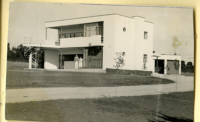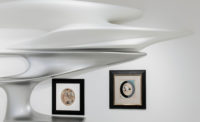François Halard, the French photographer whose work has been a staple in the pages of Vogue and Vanity Fair, built his renown shooting stylish, often decorous interiors. New York gallery Demisch Danant, on the other hand, is known for dealing in mostly midcentury French design objects. But the exhibition Francois Halard: Architecture finds both venturing into new territory.
The gallery has chosen to show 17 large prints of Halard’s work, minimally framed with no glass to gloss over richly saturated matte surfaces, as well as a selection of the photographer’s off-the-cuff-looking Polaroids taken while working on commissions. “During his travels and with his access to places, he’s done a lot of his own personal work,” explained dealer Suzanne Demisch, who collaborated with Halard to select the images on view . The result is more personal, if no less atmospheric than the work that made the photographer famous.
The photographs depict rarely seen spaces—a 1995 view out of Cy Twombly’s Gaeta, Italy, studio onto the harbor below, for example—as well as more famous, commonly photographed structures, shown here with a surprising intimacy. One particularly striking large-scale print captures both the vastness and dazzling green-nees of the avocado-colored central chamber of Paris’s Communist Party Headquarters, the domed heart of Oscar Niemeyer’s 1961 design. “I liked those images as images, but their subject also has a resonance for me,” says Demisch of the Neimeyer photographs, adding that the period and spirit of the Niemeyer images have a kinship with designers such as Joseph André Motte or Pierre Guariche, whose work she regularly shows at the gallery.
The selection of 59 Polaroids, many of which are displayed under the glass surface of a 1960s René-Jean Caillette dining room table, offer a surprise treat. A handful capture the shadows reflected by the Barcelona Pavilion’s courtyard pool and expanses of glass, pulling the venerated work down to a more human scale.
Elsewhere in the exhibition, subjects stray just wide of the architecture, occasionally veering into landscape, portraiture—including a melancholy Robert Rauschenberg—or still life. One black-and-white image is as much about the stairs climbing the roofline of Adalberto Libera’s 1937 Casa Malaparte and the surrounding Tyrrhenian Sea as it is about the house made famous by Jean-Luc Godard in the 1963 film Contempt. Meanwhile, several interior views of Carlo Mollino’s own lavish former residence in Turin use the architecture to stitch together intimate clusters of objects.
Casting his eye on these private sanctuaries and vaunted monuments, Halard has the ability to invite viewers into normally out of reach spaces, and make them feel at home.
The exhibition François Halard: Architecture is on view at Demisch Danant through March 1.




























Post a comment to this article
Report Abusive Comment